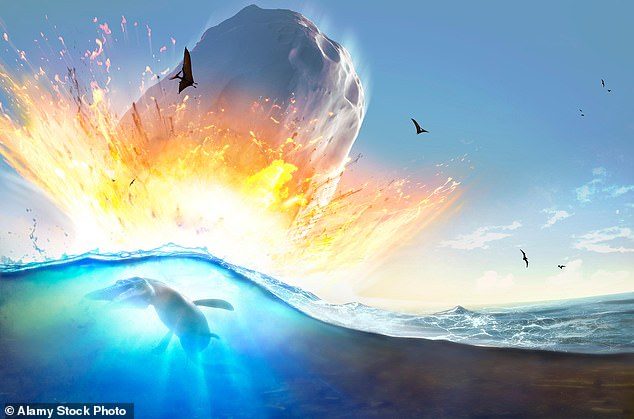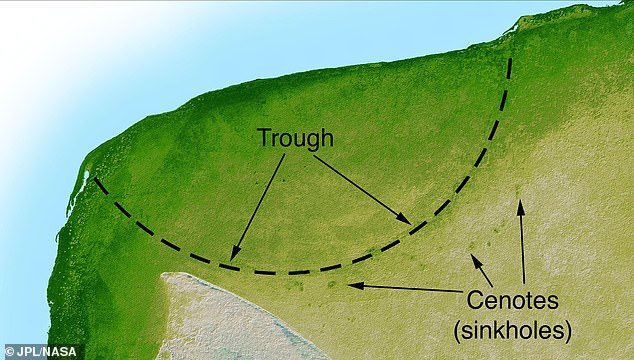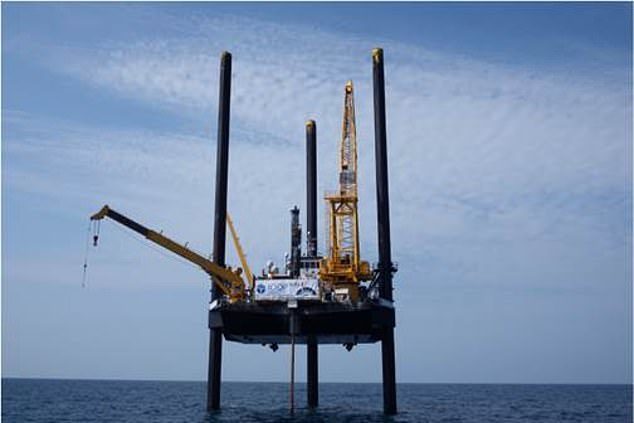
The tsunami through the Gulf of Mexico caused chaos throughout the world's oceans.
Experts have now simulated the effects for the first time - and say it was far worse than they thought.
The Chicxulub asteroid resulted in a huge global tsunami, the likes of which have not been seen in modern history,' Molly Range, who did the research while getting her master's degree in the Department of Earth and Environmental Sciences at the University of Michigan, told Livescience.
Range and her colleagues presented the research, which has yet to be published in a peer-reviewed journal, at the American Geophysical Union's annual meeting on Dec. 14 in Washington, D.C.
Here, we present what is, to our knowledge, the first global simulation of the Chicxulub impact tsunami,' they wrote.
'The impact tsunami spread quickly out of the Gulf of Mexico into the Atlantic and through the Central American seaway into the Pacific within the first 24 hours.
'Wave reflection and refraction create a more complex tsunami propagation pattern by 48 hours post-impact.
'Flow velocities exceeded 20 cm/s along shorelines worldwide and may have disturbed sediments over 6000 km from the impact origin.'
'It must have been one of the biggest tsunami ever,' Brian Arbic, a physical oceanographer at the University of Michigan who was involved in the study, told EOS.
Compared to the December 26, 2004 Indian Ocean tsunami, one of the largest tsunamis in the modern record, the impact tsunami was approximately 2600 times more energetic, the researchers said.
'This model suggests that the bolide impact not only had major effects on the global atmosphere and biosphere, it also created a tsunami of such magnitude that its effect is felt across much of the world ocean.'
In the Gulf of Mexico, water moved as fast as 89 mph (143 km/h), she found. Within the first 24 hours, the effects of the tsunami's impact spread out of the Gulf of Mexico and into the Atlantic, as well as through the Central American seaway (which doesn't exist anymore, but used to connect the Gulf to the Pacific).
After the initial nearly mile-high (1.5 km) wave, other huge waves rocked the world's oceans.
In the South Pacific and North Atlantic, waves reached a whopping maximum height of 46 feet (14 m). In the North Pacific, they reached 13 feet (4 m). Meanwhile, the Gulf of Mexico saw waves as high as 65 feet (20 meters) in some spots and 328 feet (100 m) in others.
The largest modern wave ever recorded in the Southern Hemisphere was a 'measly' 78 feet (23.8 m) tall, which struck near New Zealand in May 2018.
Another recent study found the asteroid slammed into Earth so hard it essentially turned solid ground to liquid.
This is according to a new study on an unusual ring of smashed rocks beneath Mexico's Yucatan Peninsula, where lies the massive crater left behind by the impact that killed the dinosaurs.
After many years of debate, researchers have finally gotten to the bottom of how this feature formed, revealing how colossal vibrations from the event millions of years ago shook the rock until it flowed like a liquid.
In the new study led by a team at Purdue University, researchers investigated a mountainous right of smashed rocks, known as a peak ring, along the Chicxulub crater.

Chicxulub, however, sits several miles underground and stretches more than 115 miles wide, making it difficult to study firsthand.
To get a better look, the International Ocean Discovery Program drilled a six-inch core a mile down into Earth, bringing up ancient, partially melted rock from the dinosaur-killing impact.

'For a while, the broken rock behaves as a fluid,' said Jay Melosh, a professor of earth, atmospheric, and planetary sciences at Purdue University.
'There have been a lot of theories proposed about what mechanism allows this fludization to happen, and now we know it's really strong vibrations shaking the rock constantly enough to allow it to flow.'
According to the team, the process gives rise to a 'ring of mountains' at the center of the crater, forming within minutes of the collision.
The researchers studied fracture zones and patterns in the core dredged up by a massive rig in the ocean.
In doing so, they uncovered patterns in the vibration sequence that allowed debris to flow.
These processes did not directly bring about the fall of the dinosaurs, the researchers note.
Instead, it was the external effects of the asteroid impact that caused their demise.
Comment: Scientists are still studying the details of the event and there's no consensus on what actually finished off the dinosaurs. See: We still don't know why the reign of the dinosaurs ended
But, the new understanding finally helps solve the mystery of the Chicxulub mountain ring - and, it sheds light on the possible effects of future impacts on Earth.
'These findings help us understand how impact craters collapse and how large masses of rock behave in a fluid-like manner in other circumstances, such as landslides and earthquakes,' Melosh said.
'Towns have been wiped out by enormous landslides, where people thought they were safe but then discovered that rock will flow like liquid when some disturbance sets a big enough mass in motion.'



Comment: See also: